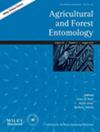Interactions between host plant quality and non-consumptive predator effects on oviposition and larval behaviour of Plutella xylostella (Lepidoptera: Plutellidae)
IF 1.8
3区 农林科学
Q2 ENTOMOLOGY
引用次数: 0
Abstract



寄主植物质量与非消耗性捕食者对褐翅栉水母(鳞翅目:栉水母科)产卵和幼虫行为的影响之间的相互作用
捕食者的存在会对猎物产生非消费性影响,从而导致猎物的行为和防御发生变化。我们研究了捕食者 Coccinella septempunctata L.(鞘翅目:Coccinellidae)各阶段(幼虫和成虫)自上而下的非消费性影响与寄主营养自下而上的影响之间的相互作用。我们还比较了完整捕食者、无下颚捕食者、密闭捕食者和无捕食者对照处理对木虱幼虫生长、存活和食草的影响。寄主植物营养影响雌性木虱成虫对寄主的选择;自下而上的寄主植物营养和七鳃鳗成虫或幼虫的存在对木虱产卵或幼虫对寄主的选择没有交互作用。捕食者的存在影响了幼虫的摄食和增重。自由移动的无下颚的七鳃鳗成虫不能捕食木虱,它们的存在使木虱幼虫的平均叶片消耗量降至 1.88 ± 0.21 平方厘米,增重降至 2.12 ± 0.16 毫克。尽管叶片损伤和幼虫增重存在差异,但非消耗性处理的存活率保持一致。完整的 C. septempunctata 幼虫减少了叶片损伤和随后的 P. xylostella 幼虫增重。然而,在非消耗性处理中,幼虫捕食者的存在对食害或增重没有影响。我们的调查结果表明,七鳃鳗会对木虱造成一些非消耗性影响,这些影响取决于捕食者的生命阶段、封闭程度和猎物的生命阶段。在发现捕食者时,木虱可能会对多种模式的线索做出反应。
本文章由计算机程序翻译,如有差异,请以英文原文为准。
求助全文
约1分钟内获得全文
求助全文
来源期刊

Agricultural and Forest Entomology
农林科学-昆虫学
CiteScore
3.60
自引率
6.20%
发文量
66
审稿时长
>24 weeks
期刊介绍:
Agricultural and Forest Entomology provides a multi-disciplinary and international forum in which researchers can present their work on all aspects of agricultural and forest entomology to other researchers, policy makers and professionals.
The Journal welcomes primary research papers, reviews and short communications on entomological research relevant to the control of insect and other arthropod pests. We invite high quality original research papers on the biology, population dynamics, impact and management of pests of the full range of forest, agricultural and horticultural crops.
 求助内容:
求助内容: 应助结果提醒方式:
应助结果提醒方式:


